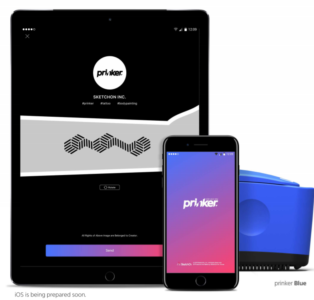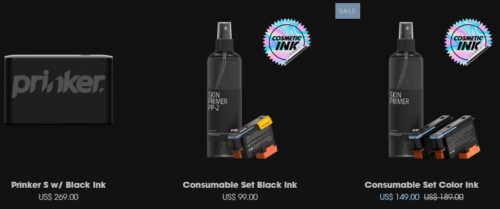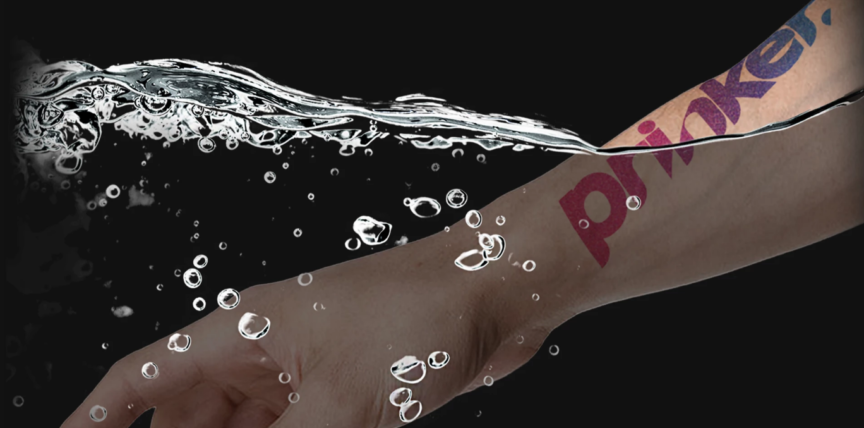At Inkjet Insight, we are all inkjet. So, when we come across different inkjet applications, we want to experience it and dissect the product ourselves. Most often we are visiting the OEM or development company to see production devices cost a few hundred thousand dollars depending to upwards of a million or more, but sometimes we learn new tricks from devices available for under a thousand.
Imagine yourself at a trade show, company outing or lunch and learn with customers; talking about all your new products, innovations and the new opportunities offered to your customers. If you have added inkjet to your book of business, sometimes it is difficult to explain how it works. So instead of just telling them, start showing them – up close and personal.
Introducing a Different Inkjet Application
Prinker is a temporary tattoo solution that jets directly on to skin at 400dpi resolution using aqueous pigment inks with skin, instead of paper, as the substrate. Prinker Korea, Inc, released its temporary tattoo solution at the July 2020 CES show. Prinker distinguishes itself from other inkjet tattoo solutions which use transfer paper and advertises its inks as “FDA cosmetic ingredients, [that are] water-resistant but can be removed with soap and water.”
This handheld device, when applied over the surface of the skin, simulates a single pass printer in concept.

Quick and easy branding with Prinker
Skin, the First Color in Inkjet Printing
Helping customers understand the importance of the substrate in your inkjet process can be exhausting. With many grades, shades, formation, calendaring, brightness, whiteness and formation it is virtually impossible to show a customer all the options they may have. The task of testing many papers on press for a customer to explain how color can shift from one paper to the next can be expensive.
Applying the “paper is the first color” analogy to skin: the tone value, porosity and formation of your skin will produce different results when the ink is jetted. The darker the skin value the darker the print may appear, but there is also less detail with reduced reflective skin values. Just as paper has a white point, shade, whiteness and brightness; respectively, so do skin types. When any of these values change so will the density and value. Your customers could get to understand media and ink interactions as well as the back of their own hand!
A New Type of Corporate Branding
This device makes it easy to create custom designs to upload via phone or tablet app for android and Apple iOS and offers a database access of over 5000 pre-made images.
Creating fun graphics that support your brand, or standard process color patches, can be rolled along your tattoo subject to quickly show a customer how the color value of an ink can change based on what it is jetted onto. Of course, you can always use paper to explain this process – but that’s not nearly as much fun. And you lose the opportunity to make your customers and prospects into living advertisements for your brand.
If a customer is not too keen on being branded, then have some fun by tattooing yourself and comparing to other colleagues or meeting attendees using this fun and creative tool for discussing media differences. Once they see how skin affects the ink hue, transition into their paper choice discussion and how different paper types can provide better or worse print. Maybe this can narrow down the paper testing you may need to do for a customer, saving you and the customer time and energy.

And No, I am Not Nuts (Usually)
I know a temporary tattoo solution is not the same as using your high-speed inkjet which prints multi drop over 600 dpi at 800 fpm. But what a fun tool to use when discussing how important the substrate is to the overall inkjet process. We all know how exciting talking about paper is [read sarcastic tone]. But, inkjet is exciting technology and anytime you can spice up a conversation with a new innovative tool, it creates a clearer message.
For the cost of $269.00 you can print mono images. Switching to color is as easy as swapping print heads for additional $149 replacement consumable set. Now you can prepare various process color value patches and your logo and have fun branding your subjects.

You can apply about 1000 non-permanent images per cartridge, lasting about 3 days unless washed directly with soap. However, the customer will remember your meeting long after the image is gone.
Uses Outside the Office
This product ditches the needle requirements of permanent conventional tattoos creating so many other uses outside of the commercial print space. School outings, identifying identical twins on the holidays or birthday parties, teaching right from left, unconventional name badges at meetings and trade shows and even a non-permanent option for spring breakers who won’t remember the night before.

Oh my, Inkjet can save lives?
Have fun and jet on my friends…

